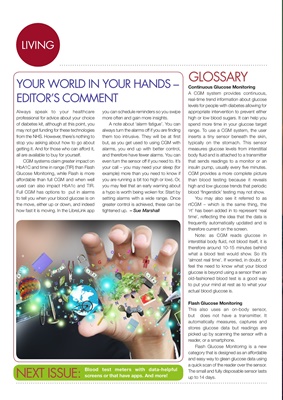
LIVINGLIVING
YOUR WORLD IN YOUR HANDS -
EDITOR'S COMMENT
Always speak to your healthcare
professional for advice about your choice
of diabetes kit, although at this point, you
may not get funding for these technologies
from the NHS. However, there's nothing to
stop you asking about how to go about
getting it. And for those who can afford it,
all are available to buy for yourself.
CGM systems claim greater impact on
HbA1C and time in range (TIR) than Flash
Glucose Monitoring, while Flash is more
affordable than full CGM and when well
used can also impact HbA1c and TIR.
Full CGM has options to put in alarms
to tell you when your blood glucose is on
the move, either up or down, and indeed
how fast it is moving. In the LibreLink app
Continuous Glucose Monitoring
A CGM system provides continuous,
real-time trend information about glucose
levels for people with diabetes allowing for
appropriate intervention to prevent either
high or low blood sugars. It can help you
spend more time in your glucose target
range. To use a CGM system, the user
inserts a tiny sensor beneath the skin,
typically on the stomach. This sensor
measures glucose levels from interstitial
body fluid and is attached to a transmitter
that sends readings to a monitor or an
insulin pump, usually every five minutes.
CGM provides a more complete picture
than blood testing because it reveals
high and low glucose trends that periodic
blood 'fingerstick' testing may not show.
You may also see it referred to as
rtCGM - which is the same thing, the
'rt' has been added in to represent 'real
time', reflecting the idea that the data is
frequently automatically updated and is
therefore current on the screen.
Note: as CGM reads glucose in
interstitial body fluid, not blood itself, it is
therefore around 10-15 minutes behind
what a blood test would show. So it's
'almost real time'. If worried, in doubt, or
feel the need to know what your blood
glucose is beyond using a sensor then an
old-fashioned blood test is a good way
to put your mind at rest as to what your
actual blood glucose is.
Flash Glucose Monitoring
This also uses an on-body sensor,
but does not have a transmitter. It
automatically measures, captures and
stores glucose data but readings are
picked up by scanning the sensor with a
reader, or a smartphone.
Flash Glucose Monitoring is a new
category that is designed as an affordable
and easy way to glean glucose data using
a quick scan of the reader over the sensor.
The small and fully disposable sensor lasts
up to 14 days.
GLOSSARY
you can schedule reminders so you swipe
more often and gain more insights.
A note about 'alarm fatigue'. You can
always turn the alarms off if you are finding
them too intrusive. They will be at first
but, as you get used to using CGM with
alarms, you end up with better control,
and therefore have fewer alarms. You can
even turn the sensor off if you need to. It's
your call - you may need your sleep (for
example) more than you need to know if
you are running a bit too high or low). Or,
you may feel that an early warning about
a hypo is worth being woken for. Start by
setting alarms with a wide range. Once
greater control is achieved, these can be
tightened up. - Sue Marshall
NEXT ISSUE: Blood test meters with screens that can keep you informed